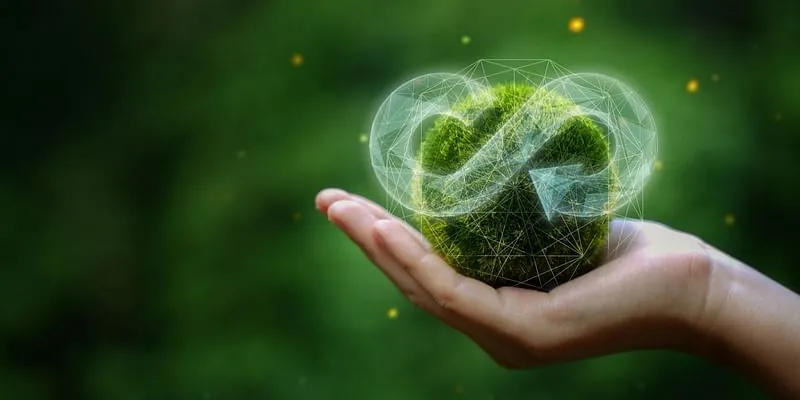Cleaning up India’s villages: a decentralised approach to waste collection and disposal
Adopting a decentralised approach to waste management can be the first step towards proper and scientific waste management in India's villages.
“Ensuring safe drinking water, sanitation and hygiene” is one of the 17 Sustainable Development Goals set under the 2030 Agenda for Sustainable Development. Clean, litter-free villages with efficient waste management systems are essential to realising this goal, which can contribute to livelihoods, healthier village habitats, resilient communities and ensure greater school attendance.
However, at present, the waste management reality of most Indian villages leaves much to be desired. A visit to any village will present you with sights of garbage piles, foul-smelling drains clogged with plastic and other biowaste, and streets littered with all forms of trash. Our villages are struggling with poor waste management.
India’s 6.4 lakh villages are home to more than two-thirds of its population and generate 0.3-0.4 million metric tons of waste per day. Despite these alarming figures, waste bins and community waste vehicles are present in less than 40% of the villages. About 67% of the 90 crore (900 million) rural households burn plastic waste, releasing pollutants like microplastic, bisphenols, and phthalates into the air, which have been linked to disruptions in neuro-development, endocrine and reproductive functions.
Indian villages and waste production
There’s a pressing need to clean up our villages. While the Swachh Bharat Abhiyan has already made great strides in this direction — 2.5 lakh villages have arrangements for solid waste management and 4.3 lakh for liquid waste management — other stakeholders such as Panchayats, NGOs, corporates, and citizens need to contribute to this cause by improving waste management infrastructure and promoting healthy and scientific waste disposal practices and habits in the whole of rural India.
One of the biggest challenges of the waste management programmes in India is that they follow a centralised system of waste collection. What it means is that waste is not segregated at source but collected and transported to a central waste disposal site. Such an arrangement of waste collection is land and capital-intensive, it is not customised to the needs of neighbourhoods within a city and between cities. Additionally, a centralised waste management system offers limited scope for innovation, community participation, and social entrepreneurship.
Adopting a decentralised approach to waste management can be the first step towards proper and scientific waste management.
Decentralise waste management
A decentralised waste management system, also known as a community-level waste management system, encourages waste segregation and treatment at or near the source. This reduces transportation costs to landfills or waste disposal sites, storage expenses and encourages community participation and awareness towards responsible waste disposable.
A decentralised model of waste management enables:
Cleaner villages: Implementing proper waste management systems in villages lead to them be litter-free and plastic-free. There are no foul-smelling garbage dumps accumulating in and around the village, leading to cleaner surroundings and therefore fewer outbreaks of diseases.
Cleaner air: With an organized waste collection and disposal system in place, villagers are discouraged from burning waste in the open leading to cleaner air.
Better Health: Untreated solid waste poses a serious health hazard as it is responsible for the spread of infectious diseases such as malaria, and diarrhoea. Removing litter and garbage dumps and cleaning up clogged drains restricts the spread of disease and improves the overall health of the village community.
Job creation: A proper waste management system involves hiring waste collectors, who go house to house to collect garbage every day. They can gainfully earn up to Rs 10,000 per month through service charge collection and from selling dry waste for recycling.
Converting wet waste to compost: Wet waste which includes vegetable peels, tea leaves, eggshells, spoiled food etc., dumped into compost pits decomposes into raw organic compost, which is used for agriculture.
Low operational costs, fewer landfills: Segregation of waste at source, into wet, dry and non-biodegradable, makes it easier for the waste collectors to process the same at the source, thereby saving transportation and operational costs and reducing the need for landfills.
Community accountability and participation: Engaging with the community, driving awareness and embarking on a behaviour change journey is one of the key components of the waste programme. When waste is segregated at source, at households, it promotes accountability in the community. Citizens take ownership of the waste they produce and follow the process to dispose of it responsibly. This awareness and sense of accountability contribute to long-term behaviour change.
Mobilise village community and councils for waste management
Cities like Pune, Chennai and Thiruvananthapuram have already experimented with decentralis

ed waste management with encouraging results. The model, however, is largely missing from the villages with a few exceptions.
Roundglass Foundation has been successfully implementing a decentralized approach to rural waste management since 2018. The Foundation has set up waste management systems in more than 200 villages, making them litter and plastic-free, and impacting the lives of more than 20,000 households.
This intervention is highly relevant and timely considering Punjab’s waste management challenges. The agrarian state generates 3700 metric tonnes of municipal solid waste per day and only 66% of this waste is processed, which is 9% less than the national average. Last year, the National Green Tribunal imposed a fine of Rs 2,000 crore on the state of Punjab for poor waste management.
Setting up a waste management system in a village involves engaging with a variety of stakeholders, including the community, youth, and the local administration. The process includes community demos and workshops, alignment with the village administration and finally enabling behaviour change at the household level by keeping the process simple and actionable.
Here are steps to set up a decentralised waste management system in a village:
Aligning with the village council (Panchayat) on allocation of space and submission of proposal to the block office for constructing a composting pit, engaging MGNREGA labour.
Conducting village-level communication workshops and demonstrations over a period of 2 weeks to engage most or the entire village household community to make them aware of why they need to dispose of their waste systematically and scientifically. As per a survey, it was found that 75% of the villagers in India didn’t know that burning waste, especially plastic, pollutes the air and impacts their health.
Providing blue and green dustbins to every household for collecting wet and dry waste respectively, thereby ensuring waste segregation at the source, keeping the process very simple and easy to adopt.
Appointing a waste collector, for a daily waste collection cycle. Typically, the waste collector charges a nominal monthly service fee from the households thereby making the programme self-sustainable.
Cleaning up litter and clearing garbage piles in the village as a one-time activity in addition to unclogging the drains.
Setting up composting pits. A typical small village of about 200 households generates approximately 80 tons of wet waste every year, which can be converted into 15-20 tons of organic compost in the village itself. Constructing compost pits creates employment opportunities for the local community. For example, in five years Roundglass Foundation engaged around 3,000 MGNREGA workers through its waste management programme. The dry waste is also collected and disposed of at a recycling facility every month.
Roundglass Foundation has now set up capacity of handling more than 15,000 tonnes of wet waste to be managed and converted into compost in more than 200 villages in Punjab. The dry waste, including paper, plastic, glass, and cardboard is also collected by the waste collector, thereby ensuring the villages are litter-free.
All this has been possible with the constant support and collaboration of the village Panchayats, volunteers, residents, and other local bodies.
Cleaner villages, healthier communities
To ensure sustainable and scalable waste management in villages, the stakeholders need to lean on active community participation, ensure building capacities at the village level to manage and maintain waste management facilities, facilitate behaviour change through sustained awareness campaigns and make the village community feel responsible towards the waste they generate and for its safe and proper disposal.
Villages form the bedrock of Indian society and politics. Clean villages can impact the wellbeing of all through cleaner air, water, and soil and by contributing to a healthy workforce. The time is now to work together to create efficient and sustainable waste management solutions for rural India (as also urban India) so that people and communities get a chance to lead healthy lives, in clean and aesthetic surroundings.
(Vishal Chowla is a leader, Roundglass Foundation.)
(Disclaimer: The views and opinions expressed in this article are those of the author and do not necessarily reflect the views of YourStory.)
Read more at: https://yourstory.com/2024/03/mergers-and-acquisitions-drive-innovation-tech-breakthroughs






